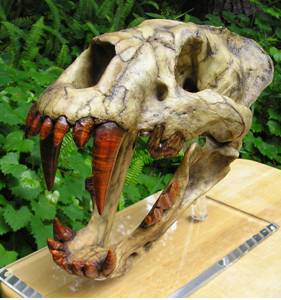
August 29, 2008

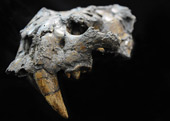
Fossils of six scimitar cats, or Homotherium, have been found along with those of glyptodons, panthers, wolves, camels, condors, ducks and horses, all who lived together about 1.8 million years ago. Perhaps the most important find was the complete skull (above) of a scimitar felid, an animal never before discovered in South America.

Homotherium
National Geographic News summarized the new find of these megafauna specimens.
The remains of an ancient scimitar cat—a relative of the mighty Ice Age predator, the sabertooth—have been found lodged in a tar pit in eastern Venezuela, scientists say.
The fierce hunter was found alongside more than 33 species of ancient animals that date back 1.8 million years, to the early Pleistocene. The scimitar cat and several of the species have never before been found in South America.
Along with six scimitar cat jaws and one skull, unprecedented finds include a type of tapir; a tooth that belonged to a spider monkey; and two species of glyptodons, large armored animals related to armadillos. ~ José Orozco reporting from Caracas, Venezuela.
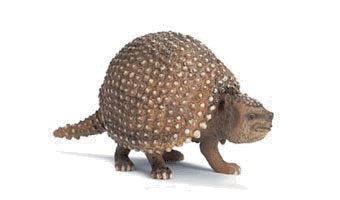
A glyptodon.
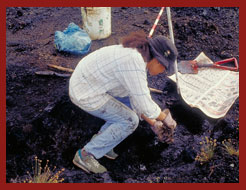
Ascanio Rincon (above) is the site’s lead researcher and a paleontologist at the state-run Venezuelan Scientific Research Institute. He notes the team found the specimens in 2006, but results of the analyses of the finds are just now being released.
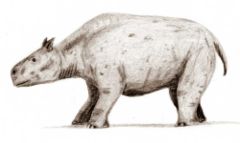
Rincon acknowledges he has only scratched the surface, but he has already collected 5,000 specimens, including horses, llamas, crocodiles, ducks, herons, the rhino-like Mixotoxodon (above), giant ground sloths, and other glyptodons.
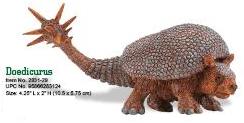
Doedicurus, a glyptodon.
It’s one of the most important paleontological finds in 20 years. The little hint is so exciting. It’s a very different story here from North America and Argentina. Its a different assemblage of mammal species. ~ Chris Bell, Pleistocene mammals expert, University of Texas at Austin who has visited the site
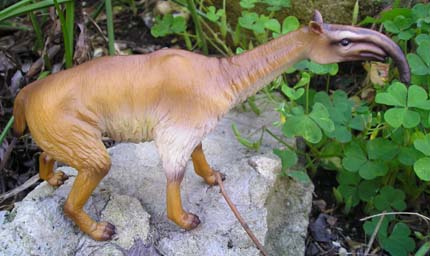
Macrauchenia
“The asphalt-preserved animals could rival those of Rancho La Brea,” said Christopher Shaw, collections manager at Los Angeles’s George C. Page Museum, which handles the La Brea collection.
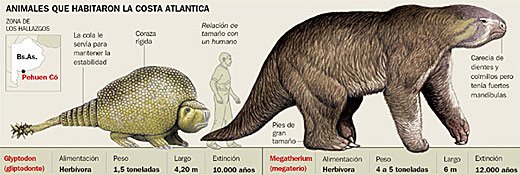
(Read more here.)

Pampatherium
Specifically, from the Journal of Vertebrate Paleontology abstract of the March 2008 paper, “Late Pleistocene Cingulates (Mammalia: Xenarthra) from Mene De Inciarte Tar Pits, Sierra De Perijá, Western Venezuela,” by Ascanio D. Rincón, Richard S. White, and H. Gregory Mcdonald, the species can be identified:
“A new assemblage of Cingulata (Xenarthra) from the late Pleistocene of northwestern Venezuela is reported. The fauna includes Dasypus sabanicola, Propraopus sulcatus, and Pampatherium humboldtii, all three of which are reported for the first time from the Venezuelan Pleistocene. Glyptodon clavipes is also reported. A systematic problem with the species of Propraopus is reported, with a suggestion for the probable inclusion of Dasypus bellus, Dasypus (Hyperoambon) kappleri, and Propraopus with its two valid species, P. punctatus and P. sulcatus, in the same genus. Hyperoambon Peters, 1865 would have seniority over Propraopus Ameghino, 1881 and would include four species, the extant D. kappleri, and the extinct D. bellus, P. punctatus, and P. sulcatus. The paleoecological aspects of the Mene de Inciarte Cingulata reflect a complex and heterogenic faunal community dominated mainly by savanna elements with some forest elements that could represent seasonally dry forest.”

Will any of these new discoveries have an impact on the debate about whether or not some glyptodons have trunks? Sclerocalyptus, a glyptodon from Argentina, might have had a trunk.
(See more on the discussions of trunks in fossil animals, by William Munns here and by Darren Naish here.)
About Loren Coleman
Loren Coleman is one of the world’s leading cryptozoologists, some say “the” leading living cryptozoologist. Certainly, he is acknowledged as the current living American researcher and writer who has most popularized cryptozoology in the late 20th and early 21st centuries.
Starting his fieldwork and investigations in 1960, after traveling and trekking extensively in pursuit of cryptozoological mysteries, Coleman began writing to share his experiences in 1969. An honorary member of Ivan T. Sanderson’s Society for the Investigation of the Unexplained in the 1970s, Coleman has been bestowed with similar honorary memberships of the North Idaho College Cryptozoology Club in 1983, and in subsequent years, that of the British Columbia Scientific Cryptozoology Club, CryptoSafari International, and other international organizations. He was also a Life Member and Benefactor of the International Society of Cryptozoology (now-defunct).
Loren Coleman’s daily blog, as a member of the Cryptomundo Team, served as an ongoing avenue of communication for the ever-growing body of cryptozoo news from 2005 through 2013. He returned as an infrequent contributor beginning Halloween week of 2015.
Coleman is the founder in 2003, and current director of the International Cryptozoology Museum in Portland, Maine.
Filed under Breaking News, Cryptotourism, CryptoZoo News, Cryptozoology, Evidence, Extinct, Fossil Finds, Megafauna, Mystery Cats, Replica Cryptia